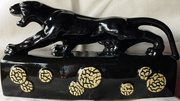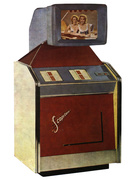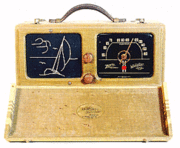In this interview, Steve McVoy talks about collecting vintage television sets, both pre-war and postwar, black and white and color. Based in Colorado, Steve is curator of the Early Television Museum, a member of our Hall of Fame.
In the 1950s when I was a teenager I used to work for a television repair shop and we’d get sets from the 40s every once in a while and I was fascinated by them. So in 1999 when I sold my business and went looking for something to do that would be challenging and different, I decided to collect television sets. I didn’t know much about television history except for television during the war.
With the first 3 or 4 sets that I bought, I met a number of collectors. It’s a pretty small community, and through the Internet I met all the major collectors in the country. They were all very nice and willing to show me their stuff, but it was all in their basements and attics and garages. At the same time, my collection was getting too big to fit in my house, so I decided to buy a warehouse and start a museum so people could see the televisions.
In 2000 we opened the Early Television Museum in Hilliard, Ohio, with about 3,000 square feet, it’s about 15,000 square feet now. We have various collections that are on loan to us, but about 95% of the televisions are mine and owned by the museum.
Collectors Weekly: Can you give us the brief history of the television from a collector’s perspective?
McVoy: Television started in the 1920s and we have about fifteen sets from 1928 – 1932. These sets were mechanical, they didn’t use the picture tube and television camera like we use today. Instead they had a rotating metal disk that creates the picture. The first television image was produced in 1927 in England. by John Logier Baird, and in 1928 the first television broadcast happened in Britain.
We also have about 25 sets from Britain that were made between 1930 and 1939. That’s where the first electronic television broadcasting took place, in 1936, at a station in London three years before televisions were available in the United States. We have an equal amount of TV sets from America before the war, all made in 1939 and 1940. Probably half the sets work, we restored a number of them for demonstration purposes.
There are only about 450 surviving pre-war TV sets in the world, they’re very rare. A few turn up each year that we didn’t know about. We also have 75 sets from right after the war, 1946 through 1955, that’s the period when television really grew. In 1947 there were only 100,000 TV sets in the country and by 1953 there were 13 million. There were hundreds of different models back then. We also have about 20 European sets from that same period. Most are from England but we also have some from France and Germany.
There were some minor differences between the British and American technologies. The British system had 405 lines while the American system had 441 before the war and 500 after the war. So the picture on the British televisions wasn’t as sharp. Our aspect ratio was 4:3 (width being 4 and height being 3), and the British ratio was 5:4. Also interesting is that a fair number of British sets had purple or pink filter material over the picture screen so it would be more interesting to watch instead of just a black and white screen.
At the museum we also have a collection of the very earliest color sets. Color TV was produced in 1950, and CBS started broadcasting in color in 1951. There were two different kinds of color sets, those with a rotating mechanical wheel and then the all electronic sets, first introduced in 1954.
Finally, we have a collection of early broadcast equipment. The highlight is a 1948 mobile production truck from RCA. This particular truck was originally owned by a station in Salt Lake City and then bought by an educational station in Ohio. They used it for a few years and then in the 1970s donated it to the Ohio Historical Society and it’s been in their warehouse since. We asked them to loan it to us so we could put it on display in the museum. It’s complete with all of its original cameras and equipment. We also have one of the first television transmitters and some early cameras.
Collectors Weekly: What are the differences between pre- and postwar television sets?
McVoy: The sophistication of the sets. During the war great progress was made on picture tube technology, so the pictures were a lot brighter and they could make bigger screens. Because of radar in World War Two they learned how to make the sets more sensitive so you could pick up more stations from farther away, so after the war there were many more channels. The British sets only had one channel, the BBC (they didn’t even have selector knobs). The American sets had three to five channels.
There were more TV sets in bars and clubs in 1947 than in homes. A bar could afford that.
Another big difference was the cost. Pre-war sets typically cost 500 or 600 dollars at the time, and you could buy a car for that in 1939. In the late 40s you could buy a good TV set for 400 dollars, and at that time that was ¼ the cost of a car. So they became more affordable after the war and got cheaper and cheaper as time went on.
Before the war only a few in London, New York City, Los Angeles, Philadelphia, and Chicago owned sets. There were also experimental television sets, radio people who built their own sets. We have a homemade set in the museum that was built from a magazine article, which printed instructions on how to built it. We also have a number of kit sets. You could buy some of the smaller sets in kit form and put them together yourself. People were experimenting with how to build the receiver. They were essentially copying the commercial sets, but with the added fun of putting it together and saving money.
Collectors Weekly: Who were some of the big television manufacturers in the U.S.?
McVoy: By far the largest was RCA. There were about 7,000 sets made in the U.S. before the war, and RCA made 3,000 of those. The second largest was General Electric and there was also Dumont, they had a television network after the war. The fourth biggest company was Andrea, which is no longer making television sets. RCA also made sets for Westinghouse and for Sears.
Most of the manufacturers were located in the Northeast, New York or Philadelphia, with the exception of one small company in Los Angeles which only made a very small quantity of televisions. In England, there were two main companies. One was HMV, which was affiliated with RCA. I think they shared a patent; and they had the same logo as RCA, the Dog sitting in front of the speaker. The other was EMI Marconi.
All the television companies were radio manufacturers who branched out into making televisions. In Britain there were 15 manufacturers before the war but HMV and Marconi made more than half the sets. The technology for televisions was developed by RCA in the U.S. David Sarnoff, who ran RCA, realized that television had a big future in the 1930s, but the depression was on at the time and he didn’t think it was the right time to introduce the system they had developed. Since they were so expensive, it wasn’t the right time to sell them, so RCA held off.
In Britain, broadcasting was government funded, so in 1936 the BBC decided to start broadcasting. When they did that, the manufacturers started building sets using the RCA design, especially the television cameras. That was the unique piece RCA developed and that the British copied. RCA waited until the 1939 World’s Fair to put out the televisions, the prices had come down and the sets could be built cheaper and more reliably. But then all production ended due to the war and the development of television stalled until 1945.
Collectors Weekly: Who are some of your favorite manufacturers and sets?
McVoy: We have a very elaborate set from Britain made by a company called RGD, which stands for Radio Gramophone Development. It has an elaborate, beautiful cabinet with a wonderful finish on it, and includes a record player and shortwave radio. For the American sets, I think General Electric has the nicest style; they’re the most unique looking. Zenith also made a spectacular looking set. Most of the televisions made in that time period were a dark mahogany, although Zenith made a blonde set that was more modern looking, I don’t think they made more than ten of them and there’s only one that survived.
There’s one designer who worked for RCA, John Vassos, who designed a lot of RCA’s radio cabinets. He was famous at the time for his design and he designed the 1930 RCA television sets. The other manufacturers used their radio cabinets and copied them.
Collectors Weekly: Where do you find old television sets to add to the museum’s collection?
McVoy: I’ve bought a fair number on eBay, but not recently. The vast majority comes from other collectors. Everybody knows the museum and we have a convention every year and there are about 110 serious collectors that show up. Many collectors if they have more than one of something they will sell their second piece. With museums, people are willing to donate stuff they don’t have room for. As time goes one more and more people want to donate and it’s harder for us to acquire new stuff because we have all of the more common sets and the ones we’re looking for now are very rare.
An example of a rare and obscure television we have at the museum is a 1930 Italian mechanical set and it’s the only one we know of. It’s unique because it looks like more of a 1950s style; it’s very unique looking. We also have a prototype projection set from 1954 and it’s the only one that exists. It’s pretty much like the ones today, a small picture tube with a lens arrangement that projects the image up on the screen. Ours is a real projection set meaning everything is inside a cabinet and the picture tube is in the bottom of the cabinet. That was very common right after the war because they didn’t know how to make picture tubes more than 12 inches and the only way to get a bigger screen was to use a small light tube and a projection system.
Especially right after the war, the first places TV sets went were bars and clubs, so to get a picture big enough they’d use the projection systems. In 1948 the World Series was on television and millions of people saw it and there were only a few hundred sets in the country. So people were watching it in bars and clubs. I think there were more sets in bars and clubs in 1947 than in homes. TVs were $400 to $500 at the time and a projection set was $1,000 and a bar could afford that.
We also have a 1946 television jukebox that is elaborately made out of glass. You could put a quarter in it and watch 30 minutes of television or listen to five songs. Another unique item is our CBS color sets with the wheel in front of them. They are probably the only ones that survived.
Collectors Weekly: What types of television sets do most collectors tend to collect?
There are guys on very limited budgets who collect the more common models from the late 40s and early 50s. They find them in garage sales, thrift shops, and antique stores that still exist in the Northeast. At any radio swap meet you can find television sets, but mostly common sets. Another source is auctions. We actually had our first auction this year and it was so successful that we’re going to make it an annual event and ask other collectors to join and sell some items.
For black and white sets made after 1949, the values drop off dramatically, with some exceptions, because few collectors are interested in those sets. There are people who collect early transistor sets from the 1960s and 70s, and they have some value. And some specialty collectors collect the micro TV sets. But the vast majority collect black and white sets from 1939 to 1949 and color sets through 1960. After the mid 1950s manufacturers started putting their television sets in metal cabinets which had very little style, they’re not very attractive after that period. And there were a lot more TVs produced after the mid 1950s so there are just so many around.
Collectors Weekly: What are some good information resources on collecting early television sets?
McVoy: There’s a price guide that I was a contributing editor for, but prices vary widely because there aren’t a lot of buyers. There’s also our website and tvhistory.tv, which are probably the best sites on collecting and restoring sets. There are some books on television history, but they have nothing about collecting. In the U.S. there’s no television collecting club specifically, but there are collectors who belong to many radio clubs.
In Britain there are two organizations. The British Vintage Wireless Association has a subset called the 405 Alive and they have a little publication that is television related. There’s also The Narrow Bandwidth Television Association. These are people who are interested in mechanical televisions, but their specialty is more in building the TV sets to the old standards.
(All images in this article courtesy Steve McVoy of The Early Television Museum)






 Scopitone: '60s Music Videos You've Never Seen
Scopitone: '60s Music Videos You've Never Seen
 Tacky Treasures: TV Lamps of the 1950s
Tacky Treasures: TV Lamps of the 1950s Scopitone: '60s Music Videos You've Never Seen
Scopitone: '60s Music Videos You've Never Seen Understanding Antique Radios
Understanding Antique Radios TelevisionsThe basic technology for electronic television (as opposed to earlier mecha…
TelevisionsThe basic technology for electronic television (as opposed to earlier mecha… Mari Tepper: Laying it on the Line
Mari Tepper: Laying it on the Line Nice Ice: Valerie Hammond on the Genteel Charm of Vintage Canadian Costume Jewelry
Nice Ice: Valerie Hammond on the Genteel Charm of Vintage Canadian Costume Jewelry How Jim Heimann Got Crazy for California Architecture
How Jim Heimann Got Crazy for California Architecture Modernist Man: Jock Peters May Be the Most Influential Architect You've Never Heard Of
Modernist Man: Jock Peters May Be the Most Influential Architect You've Never Heard Of Meet Cute: Were Kokeshi Dolls the Models for Hello Kitty, Pokemon, and Be@rbrick?
Meet Cute: Were Kokeshi Dolls the Models for Hello Kitty, Pokemon, and Be@rbrick? When the King of Comedy Posters Set His Surreal Sights on the World of Rock 'n' Roll
When the King of Comedy Posters Set His Surreal Sights on the World of Rock 'n' Roll How One Artist Makes New Art From Old Coloring Books and Found Photos
How One Artist Makes New Art From Old Coloring Books and Found Photos Say Cheese! How Bad Photography Has Changed Our Definition of Good Pictures
Say Cheese! How Bad Photography Has Changed Our Definition of Good Pictures Middle Earthenware: One Family's Quest to Reclaim Its Place in British Pottery History
Middle Earthenware: One Family's Quest to Reclaim Its Place in British Pottery History Fancy Fowl: How an Evil Sea Captain and a Beloved Queen Made the World Crave KFC
Fancy Fowl: How an Evil Sea Captain and a Beloved Queen Made the World Crave KFC
Hi!i got a Philco 50-T701 & 50-702 tv made in 7-51 cat still get a picture tube for the set the No. Is 7JP4
Thanks
i have a panasonic color t v model ct 1110d ser#kb4621934 in good condition
ten inch screen what can i do with it
I have a old Motorola TV that reassembles an old suitcase, and the front opens to reveal a TV. Aprox. 81/4 screen, round. Nice looking case, and everything appears to be intact. I’ve searched on line, but cannot find one like this. Has wooden case covered in a reddish-brown material. I think a collector should have this. Can you help?
Hi I have a 1957 Motorola 21T319CH with the original stand. It has been in my family and my house since it was new. Still hums when you turn it on. What can you tell me about it and what it is worth please?
I have a RCA Victor TV model 6-T-74 I don’t know if it works I would like someone in the Los Angles area that could fix if needed and I would like to obtain an owners manual that shows what all the controls are for.
At a recent estate sale, I saw a old TV that was unlike any other I have seen.
I was told if it didn’t sell, they would take it to a local landfill. I bought it
to assure that wouldn’t happen! I can send photos, if there is any interest.
I live in Dayton, Ohio, and would like to see this go to a good home!
I’m not selling it, but maybe I can help ship it.